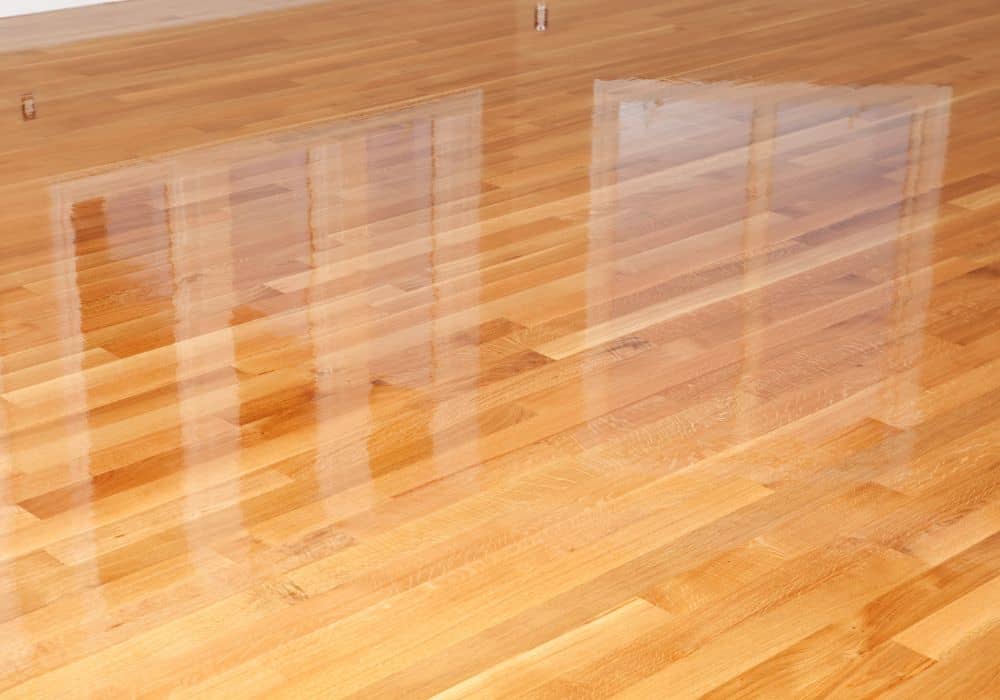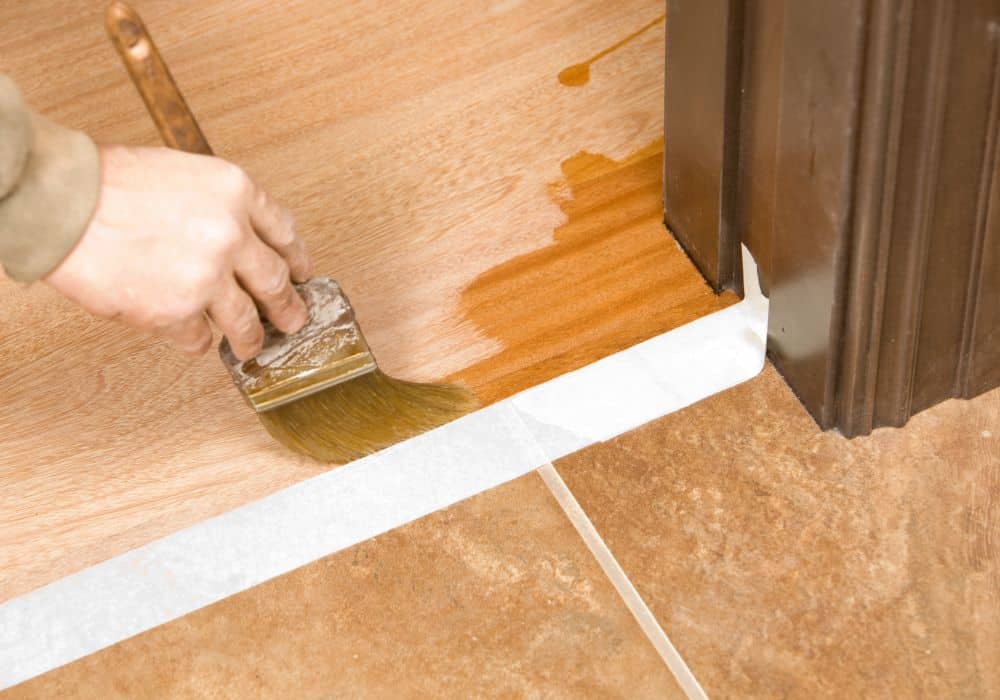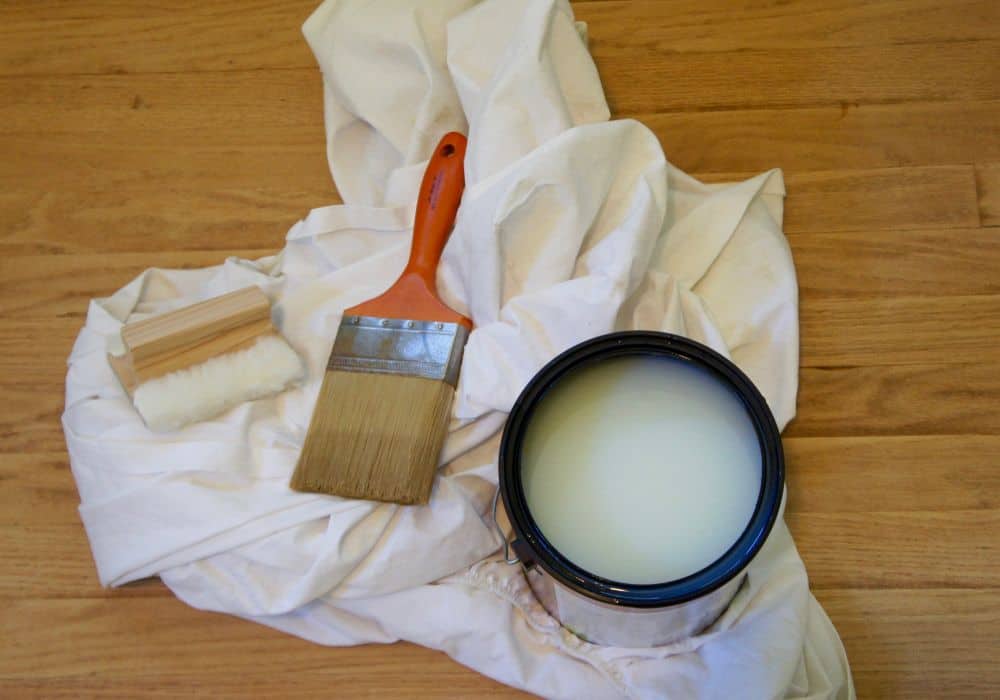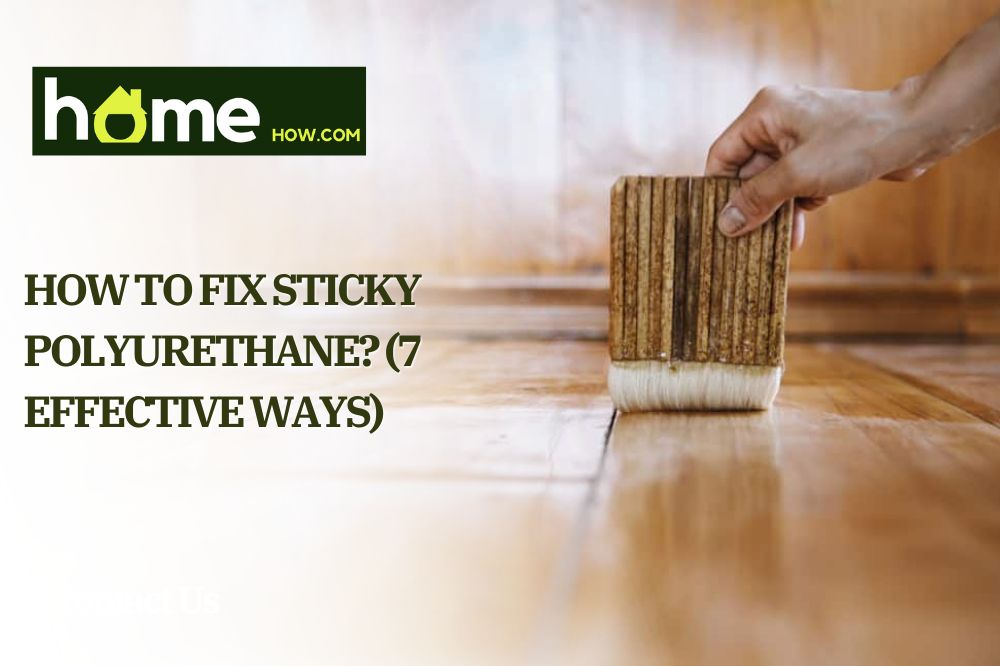Stained wood is beautiful, and it’s a great way to upgrade pieces of furniture, cabinets, or even your floors! When you stain wood, it is absolutely necessary to seal it, and polyurethane is the most popular and durable sealant. However, sometimes things go wrong in the process, and your polyurethane just doesn’t seem to be hardening like it should be.
So, how do you fix sticky polyurethane? Keep reading to find out.
Tools You’ll Need
- Dehumidifier
- Heat Gun
- Fan
- Mask
- Gloves
- Goggles
- Rag
- Sandpaper
- Paint Thinner
- Paintbrush or roller
- Plastic Scraper
How To Fix Sticky Polyurethane

Polyurethane is easy to use if you take the proper steps and apply it properly. But even professionals end up with a sticky polyurethane situation from time to time. There are a few different things you can try when it comes to fixing sticky polyurethane.
It could be as simple as waiting a bit longer or as much as starting from square one. Listed below are the best ways to try and fix sticky polyurethane. Your best bet is to try a few different methods to see which one may work for you!
Don’t forget to check out the extended tips at the bottom on how you can apply polyurethane like a pro!
1. Give It Time
If your polyurethane is still tacky, try giving it more time to dry. Sometimes, certain polyurethanes have a longer dry time and cure time, especially if they are oil-based polyurethane. If you are dealing with oil-based poly, you may need to give it more dry time before you can expect it to dry completely.
Water-based polyurethane typically doesn’t take as long and is usually ready for another coat between 6-12 hours after it is applied, whereas oil-based takes 24-48 hours on the low end.
If the polyurethane still has a strong odor, this is likely the cause, and a bit of patience will help you in this situation. If it has already sat for 3-4 days and it is still sticky, it is time to try other methods.
2. Use A Dehumidifier
High Humidity is one of the most common reasons that sealants don’t dry properly. When humidity levels are above 65%, moisture accumulates on the surface, preventing the sealant from drying properly.
Try running a dehumidifier for at least 24 hours to see if it helps the polyurethane to dry. If you don’t have a dehumidifier, you could try pointing a fan in the area to keep the air circulating and not remaining stagnant.
Whatever you do, don’t apply another coat of polyurethane if you are dealing with a relatively humid environment. This will cause moisture to get trapped between to the coats, and you will only be able to fix it by starting over.
3. Try A Heat Gun

Another thing you can try when dealing with sticky polyurethane is a heat gun. Going over the surface slowly with a heat gun will help add warmth to the polyurethane helping it to dry and cure faster as well as help to help the solvents evaporate. Alternatively, you can use a heat lamp or even a hair dryer.
This is especially helpful if you are working in a cold environment, as polyurethane needs warmth to dry properly. Ideally, the temperature should be between 70 and 77 degrees. Colder than 70 degrees can result in sticky polyurethane.
4. Open The Doors And Windows
Allowing good ventilation around your project may be helpful in fixing sticky polyurethane.
Ventilation will aid in the evaporation of the solvents in the sealant by allowing fresh air to enter the room and letting out any trapped humid air that may be causing your finish to take longer to dry.
5. Use Mineral Spirits
One common mistake is applying your polyurethane too thick. If you lay on heavy coats of the sealant, you may want to try using mineral spirits to try and get rid of the excess stickiness.
Just lightly dampen a rag with the mineral spirits and wipe down the surface until the stickiness starts to go away. Just don’t oversaturate the surface with mineral spirits, or it may eat through all of your polyurethane, requiring you to start over.
6. Try Another Sealent

If you are still having trouble with sticky polyurethane, you can try to use another sealant on top. You need to choose a sealant that does not need to cure, such as shellac or other resins.
Just use a paintbrush to brush a thin layer of sealant over the top of the polyurethane and let it dry according to the directions on the sealant label.
7. Start From Scratch
Sometimes, there is just no way to fix your polyurethane. It could be something on your end, or it could just be a bad batch of sealant. Either way, you may have to remove the polyurethane and start all over again.
Even if you were able to get off most of the stickiness, but it still doesn’t feel completely dry and hard, you will want to just start over. The polyurethane not behaving correctly will ultimately have an effect on the durability of the sealant in the long run.
To remove the polyurethane, you will want to make sure you are taking safety measures. Make sure you are wearing a mask, goggles, and appropriate gloves, as paint thinner is a harsh chemical.
You will also want to cover your floor or any area you don’t want to be harmed, as the polyurethane will strip the varnish off of many surfaces.
Next, use a paintbrush or roller to saturate the surface in paint thinner and let it sit for at least 10 minutes or until it starts to bubble.
Now, use a plastic scraper to scrape off the varnish. It shouldn’t be hard to remove, so if it is giving you resistance, let it sit longer.
After you remove the varnish, wipe the surface with a wet rag to remove excess polyurethane, then dry the surface with a dry cloth. I recommend giving it a light sanding to ensure all of the polyurethane and paint thinner has been removed from the surface.
Now, you are ready to reapply.
Extended Tips
- Always read the directions on the back of your stain. Some stains take longer than others to dry, and applying your polyurethane too soon will cause it to not cure properly, making it sticky.
- Make sure you prep the surface efficiently. Be sure to sand the surface before you apply your polyurethane. If you apply polyurethane on top of old polyurethane, you are just asking for trouble.
- You should always stir polyurethane very slowly. Stirring the sealant too quickly will introduce air bubbles, resulting in tacky and rough polyurethane that doesn’t cure correctly.
- Don’t apply the polyurethane coating too heavily, as this could make it harder for it to dry or prevent it from drying fully at all. To help apply the sealant properly, use an appropriate brush made specifically for polyurethane and apply it in thin coats.
- Just like you need to make sure your stain dries all the way before applying polyurethane, always make sure the first coat of poly is completely dry before applying another coat. Failure to do this will result in the solvent not fully evaporating from the first coat and getting trapped under the second coat, resulting in delayed drying and curing time.
- You must always sand your polyurethane and clean it well before applying another coat to ensure dirt and dust don’t get trapped between the coats
- Choose the right polyurethane finish. There are different polyurethanes for different projects, and choosing the right one is vital for your sealant to dry and cure properly.
Conclusion
You can try a few different things when it comes to fixing sticky polyurethane! Even if you have to start over, you can look at it as a learning opportunity to fix something you may have done incorrectly, and you will do better the next time.
Even if you did everything perfectly, sometimes polyurethane just doesn’t cure correctly, and that isn’t your fault. All DIY projects are subject to trial and error, so don’t give up!
We hope you found this article helpful. Have you ever had to deal with sticky polyurethane? How did you fix it? Did you try a method that isn’t listed? Let us know in the comments below, as well as if you have any questions or concerns! We love to hear from our readers!
